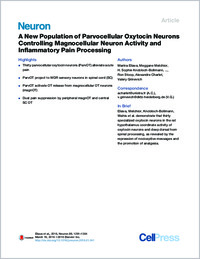A New Population of Parvocellular Oxytocin Neurons Controlling Magnocellular Neuron Activity and Inflammatory Pain Processing.
- Eliava M Schaller Research Group on Neuropeptides at German Cancer Research Center (DKFZ) and Cell Network Cluster of Excellence at the University of Heidelberg, Heidelberg 69120, Germany.
- Melchior M Institut of Cellular and Integrative Neurosciences (INCI) UPR3212, Centre National de la Recherche Scientifique (CNRS), University of Strasbourg, Strasbourg 67084, France.
- Knobloch-Bollmann HS Schaller Research Group on Neuropeptides at German Cancer Research Center (DKFZ) and Cell Network Cluster of Excellence at the University of Heidelberg, Heidelberg 69120, Germany; Max Planck Institute for Medical Research, Heidelberg 69120, Germany.
- Wahis J Institut of Cellular and Integrative Neurosciences (INCI) UPR3212, Centre National de la Recherche Scientifique (CNRS), University of Strasbourg, Strasbourg 67084, France.
- da Silva Gouveia M Schaller Research Group on Neuropeptides at German Cancer Research Center (DKFZ) and Cell Network Cluster of Excellence at the University of Heidelberg, Heidelberg 69120, Germany.
- Tang Y Schaller Research Group on Neuropeptides at German Cancer Research Center (DKFZ) and Cell Network Cluster of Excellence at the University of Heidelberg, Heidelberg 69120, Germany; Institute of Brain Functional Genomics, East China Normal University, Shanghai 200062, China.
- Ciobanu AC Center for Psychiatric Neurosciences, Hôpital de Cery, Lausanne University Hospital (CHUV), Lausanne 1008, Switzerland.
- Triana Del Rio R Center for Psychiatric Neurosciences, Hôpital de Cery, Lausanne University Hospital (CHUV), Lausanne 1008, Switzerland.
- Roth LC Schaller Research Group on Neuropeptides at German Cancer Research Center (DKFZ) and Cell Network Cluster of Excellence at the University of Heidelberg, Heidelberg 69120, Germany; Max Planck Institute for Medical Research, Heidelberg 69120, Germany.
- Althammer F Schaller Research Group on Neuropeptides at German Cancer Research Center (DKFZ) and Cell Network Cluster of Excellence at the University of Heidelberg, Heidelberg 69120, Germany.
- Chavant V Institut of Cellular and Integrative Neurosciences (INCI) UPR3212, Centre National de la Recherche Scientifique (CNRS), University of Strasbourg, Strasbourg 67084, France.
- Goumon Y Institut of Cellular and Integrative Neurosciences (INCI) UPR3212, Centre National de la Recherche Scientifique (CNRS), University of Strasbourg, Strasbourg 67084, France.
- Gruber T Schaller Research Group on Neuropeptides at German Cancer Research Center (DKFZ) and Cell Network Cluster of Excellence at the University of Heidelberg, Heidelberg 69120, Germany; Max Planck Institute for Medical Research, Heidelberg 69120, Germany.
- Petit-Demoulière N Institut of Cellular and Integrative Neurosciences (INCI) UPR3212, Centre National de la Recherche Scientifique (CNRS), University of Strasbourg, Strasbourg 67084, France.
- Busnelli M National Research Council, Institute of Neuroscience, Milan 20129, Italy.
- Chini B National Research Council, Institute of Neuroscience, Milan 20129, Italy; Humanitas Clinical and Research Center, Rozzano 20089, Italy.
- Tan LL Department for Molecular Pharmacology and Molecular Medicine Partnership Unit with European Molecular Biology Laboratories, Institute of Pharmacology, Heidelberg University, Heidelberg 69120, Germany.
- Mitre M Skirball Institute of Biomolecular Medicine, New York University School of Medicine, New York, NY 10016, USA.
- Froemke RC Skirball Institute of Biomolecular Medicine, New York University School of Medicine, New York, NY 10016, USA.
- Chao MV Skirball Institute of Biomolecular Medicine, New York University School of Medicine, New York, NY 10016, USA.
- Giese G Max Planck Institute for Medical Research, Heidelberg 69120, Germany.
- Sprengel R Max Planck Institute for Medical Research, Heidelberg 69120, Germany.
- Kuner R Department for Molecular Pharmacology and Molecular Medicine Partnership Unit with European Molecular Biology Laboratories, Institute of Pharmacology, Heidelberg University, Heidelberg 69120, Germany.
- Poisbeau P Institut of Cellular and Integrative Neurosciences (INCI) UPR3212, Centre National de la Recherche Scientifique (CNRS), University of Strasbourg, Strasbourg 67084, France.
- Seeburg PH Max Planck Institute for Medical Research, Heidelberg 69120, Germany.
- Stoop R Center for Psychiatric Neurosciences, Hôpital de Cery, Lausanne University Hospital (CHUV), Lausanne 1008, Switzerland.
- Charlet A Institut of Cellular and Integrative Neurosciences (INCI) UPR3212, Centre National de la Recherche Scientifique (CNRS), University of Strasbourg, Strasbourg 67084, France; University of Strasbourg Institute for Advanced Study (USIAS), Strasbourg 67000, France. Electronic address: acharlet@unistra.fr.
- Grinevich V Schaller Research Group on Neuropeptides at German Cancer Research Center (DKFZ) and Cell Network Cluster of Excellence at the University of Heidelberg, Heidelberg 69120, Germany; Max Planck Institute for Medical Research, Heidelberg 69120, Germany; Central Institute of Mental Health (ZI), Mannheim 68159, Germany. Electronic address: v.grinevich@dkfz-heidelberg.de.
- 2016-03-08
Published in:
- Neuron. - 2016
Action Potentials
Animals
Cholecystokinin
Disease Models, Animal
Excitatory Amino Acid Antagonists
Gene Expression Regulation
Inflammation
Neural Pathways
Neuralgia
Neurons
Oxytocin
Paraventricular Hypothalamic Nucleus
Quinoxalines
Rats
Rats, Wistar
Receptors, Oxytocin
Spinal Cord
Supraoptic Nucleus
Transduction, Genetic
Vasopressins
Vesicular Glutamate Transport Protein 2
English
Oxytocin (OT) is a neuropeptide elaborated by the hypothalamic paraventricular (PVN) and supraoptic (SON) nuclei. Magnocellular OT neurons of these nuclei innervate numerous forebrain regions and release OT into the blood from the posterior pituitary. The PVN also harbors parvocellular OT cells that project to the brainstem and spinal cord, but their function has not been directly assessed. Here, we identified a subset of approximately 30 parvocellular OT neurons, with collateral projections onto magnocellular OT neurons and neurons of deep layers of the spinal cord. Evoked OT release from these OT neurons suppresses nociception and promotes analgesia in an animal model of inflammatory pain. Our findings identify a new population of OT neurons that modulates nociception in a two tier process: (1) directly by release of OT from axons onto sensory spinal cord neurons and inhibiting their activity and (2) indirectly by stimulating OT release from SON neurons into the periphery.
- Language
-
- English
- Open access status
- bronze
- Identifiers
-
- DOI 10.1016/j.neuron.2016.01.041
- PMID 26948889
- Persistent URL
- https://sonar.ch/global/documents/265314
Statistics
Document views: 36
File downloads:
- fulltext.pdf: 0
